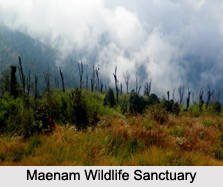 The state of Sikkim is located in the north eastern part of India. The geographical terrain of this state is characterized by mountains, glaciers, hot springs, rivers and streams. They not only beautify Sikkim but also draw a plethora of tourists here. Wildlife Sanctuaries of Sikkim are no exception in this regard. They also have the potential to attract the attention of tourists visiting the state.
The state of Sikkim is located in the north eastern part of India. The geographical terrain of this state is characterized by mountains, glaciers, hot springs, rivers and streams. They not only beautify Sikkim but also draw a plethora of tourists here. Wildlife Sanctuaries of Sikkim are no exception in this regard. They also have the potential to attract the attention of tourists visiting the state.
Fambong Lho Wildlife Sanctuary
Fambong Lho Wildlife Sanctuary is located at the junction of Palearctic ecozone and Indomalaya ecozone, in the East Sikkim district. It was established in the year 1984 and is spread over an area of about 51.760 square kilometers. This sanctuary provides shelter to a large variety of mammalian and avian fauna. Riverine tributaries of the sanctuary help in the betterment of its biodiversity.
Kyongnosla Alpine Sanctuary
 Kyongnosla Alpine Sanctuary is situated in East Sikkim. This wildlife sanctuary was established in the year 1977 and is spread over an area of about 31 square kilometers. This sanctuary is known to provide protection to threatened species. More specifically, rare, endangered ground orchids and rhododendrons interspersed among tall junipers and taller silver fir exist here. Those on the verge of extinction like Rhododendron Niveum and Cypripedium Tibeticum have also been included in the sanctuary.
Kyongnosla Alpine Sanctuary is situated in East Sikkim. This wildlife sanctuary was established in the year 1977 and is spread over an area of about 31 square kilometers. This sanctuary is known to provide protection to threatened species. More specifically, rare, endangered ground orchids and rhododendrons interspersed among tall junipers and taller silver fir exist here. Those on the verge of extinction like Rhododendron Niveum and Cypripedium Tibeticum have also been included in the sanctuary.
Maenam Wildlife Sanctuary
Maenam Wildlife Sanctuary is housed in South Sikkim district. This wildlife reserve was established in the year 1987 and is spread over an area about 35 square kilometers. Plants of medicinal value have lent popularity to this sanctuary.
Pangolakha Wildlife Sanctuary
Pangolakha Wildlife Sanctuary is located at the junction of Palearctic ecozone and Indomalaya ecozone in the East Sikkim district. It was established in the year 1999 and is spread over an area of about 124 square kilometers. It serves as a home to a large variety of animals.
Barsey Rhododendron Sanctuary
Barsey Rhododendron Sanctuary is situated in the south west corner of the West Sikkim district. It was established in the year 2004 and is spread over an area of about 104 square kilometers. As the name of the sanctuary suggests, rhododendrons form a part of it. This sanctuary comprises of faunal species like leopard cat, Himalayan yellow throated marten, Himalayan palm civet, Himalayan langur, crimson horned pheasant, monal pheasant and kaleej. It also houses diverse species of birds.
Shingba Rhododendron Sanctuary
Shingba Rhododendron Sanctuary is located in North Sikkim. This sanctuary was established in the year 1984 and is spread over an area of about 4,300 hectares. This sanctuary is known for housing about 40 species of rhododendron trees and bird species like wood snipe and hoary-throated barwing.











